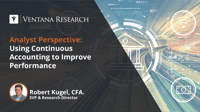As we celebrate the first half of what seems to be the year of generative artificial intelligence, with an apparently unlimited discussion of use cases and bogeymen, my attention is turning to the very mundane question of costs. Specifically, how costs incurred – through investment and operation – will be distributed along the value chain and how this will affect the demand for AI ‒ by whom and for what purpose. It’s a question that needs asking even though, at this stage in the market’s...
Read More
Topics:
Office of Finance,
Continuous Planning,
Business Planning,
Enterprise Resource Planning,
natural language processing,
digital finance,
AI & Machine Learning,
Consolidate/Close/Report,
Continuous Supply Chain & ERP
I recently attended Sage Software’s Partner Summit. Implementation partners account for most of the sales and implementation of finance and accounting applications designed for small and midsize businesses, so they are important to the success of the software vendor. These events are designed to inform partners of product enhancements and the product and technology roadmap as well as provide a perspective on market conditions and trends.
Read More
Topics:
Office of Finance,
Business Planning,
ERP and Continuous Accounting,
digital finance,
AI & Machine Learning,
Purchasing/Sourcing/Payments,
Consolidate/Close/Report
The Office of Finance can be compared to a numbers factory where the main raw material, data, is transformed into financial statements, management accounting, analyses, forecasts, budgets, regulatory filings, tax returns and all kinds of reports. Data is the strategic raw material of the finance and accounting department. It is the key ingredient in every sale and purchase as well as every transaction of any description. Quality control is essential to achieving high standards of output in any...
Read More
Topics:
Office of Finance,
embedded analytics,
Analytics,
Business Intelligence,
Data Management,
Business Planning,
ERP and Continuous Accounting,
data operations,
digital finance,
AI & Machine Learning,
operational data platforms,
Analytic Data Platforms,
Revenue, Lease and Tax Accounting,
Purchasing/Sourcing/Payments,
Consolidate/Close/Report
We’ve experienced an unusual, decades-long monetary policy in the developed world that emphasized interest rate repression as well as supply chain practices designed for lowest cost. This has produced a generation of chief financial officers likely unprepared to address the impact of fundamental changes now shaping a new, technology-driven approach to working capital optimization. Today’s CFOs must assess their working capital management processes and the systems that support them to balance...
Read More
Topics:
Office of Finance,
Enterprise Resource Planning,
continuous supply chain,
digital finance,
Sustainability Management,
Purchasing/Sourcing/Payments
OneStream offers a platform designed to serve the needs of accounting and financial planning and analysis organizations. The software handles financial close and consolidation, planning and budgeting, analysis and reporting. The most notable part of the company’s presentations at its annual user group meeting – Splash – was the strategy and roadmap for its two artificial intelligence initiatives, Sensible ML and Sensible GPT. The former, unveiled last year, is a platform approach to applying...
Read More
Topics:
Office of Finance,
digital finance,
AI & Machine Learning
In 2015, I began using the term continuous accounting to call attention to technology advances that enable finance and accounting departments to improve performance. These advances have continued, making an even more compelling case for adoption of continuous accounting.
Read More
Topics:
Office of Finance,
ERP and Continuous Accounting,
digital finance,
Purchasing/Sourcing/Payments,
Consolidate/Close/Report
The chief financial officer of a midsize organization faces a different set of challenges than those in larger or smaller enterprises. These organizations have grown to the point of requiring capabilities similar to larger businesses, but typically lack the staff or financial resources afforded to bigger organizations. The past decade of IT innovation – especially the expansion of cloud computing – has brought substantial benefits to midsize finance and accounting operations. Rapidly growing...
Read More
Topics:
Office of Finance,
Business Planning,
ERP and Continuous Accounting,
digital finance,
Consolidate/Close/Report
Early last December, just before ChatGPT became the new, bright, shiny object, The Economist magazine ran a story proclaiming that we had finally arrived at the age of boring artificial intelligence (AI). From my perspective, it’s unfortunate that didn’t last and that AI has been relegated back to the buzzword league. AI will be an increasingly important feature of business software through the end of this decade. Ventana Research asserts that by 2026, almost all vendors of software designed...
Read More
Topics:
Office of Finance,
Business Intelligence,
Business Planning,
Enterprise Resource Planning,
ERP and Continuous Accounting,
natural language processing,
continuous supply chain,
digital finance,
AI & Machine Learning,
Purchasing/Sourcing/Payments,
Consolidate/Close/Report
As a rule, I dislike terms like “digital finance transformation” because there’s a wave-the -magic-wand quality to it that obscures the not-so-simple people and process elements necessary for true transformation. Six of the most common – and expensive – words used in an accounting department are “we’ve always done it this way.” Persuading staff to change can be a struggle, even if change makes their jobs easier and more rewarding. Moreover, digital transformation must cover the data elements as...
Read More
Topics:
Office of Finance,
digital finance,
Consolidate/Close/Report
An external audit examines an organization’s performance of accounting tasks. It validates the soundness of accounting systems and policies and compliance with generally accepted accounting principles in preparing financial statements – chiefly the income statement, balance sheet and statements of cash flow and equity. The auditor certifies that there are no material errors or omissions, and that the financial statements are compliant with requirements. Technology can transform this process to...
Read More
Topics:
Office of Finance,
digital finance,
Consolidate/Close/Report




















